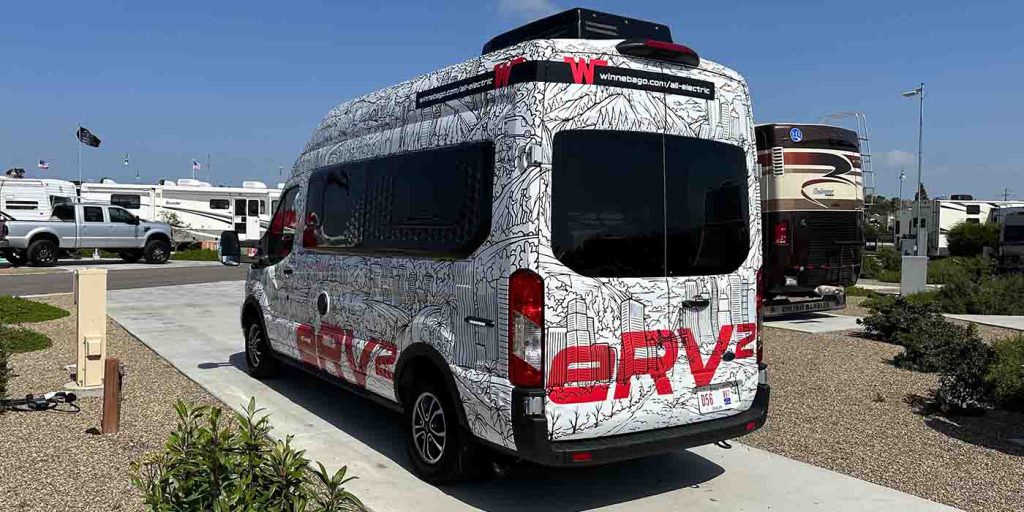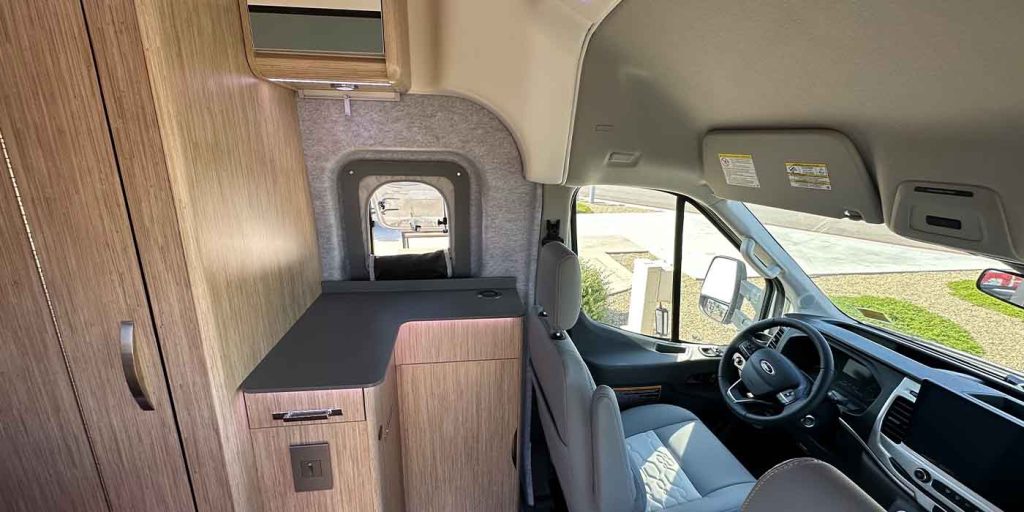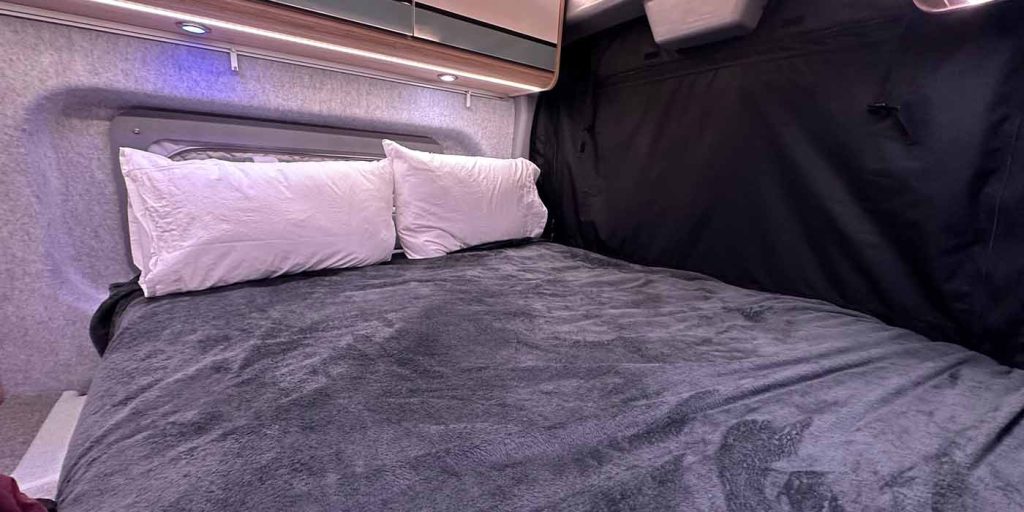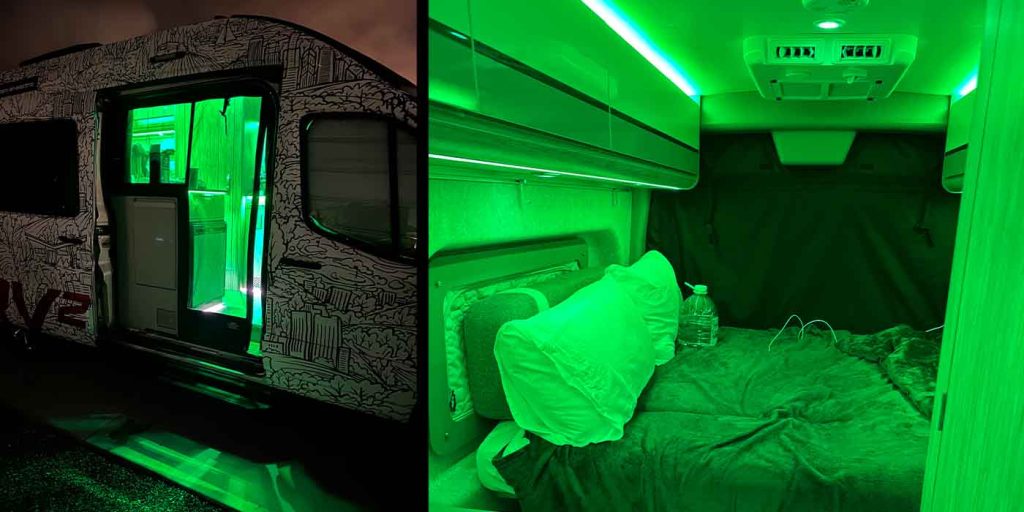
Since it was first unveiled this past January, Winnebago’s all-electric eRV2 prototype has been on my radar as an EV I’d love to experience firsthand, especially since many of my loaners are focused solely on driving, and this electric RV offers so much more. Winnebago gave me the chance to take the eRV2 for a spin, and I spent the night in it down in San Diego. Check out my thoughts and video review below.
Table of contents

The eRV2 is Winnebago’s first all-electric prototype
While Winnebago has a well established history in recreational vehicles in which its own name has become synonymous with the segment, its journey into electric vehicles remains nascent.
During the 2022 Florida RV SuperShow, Winnebago unveiled the eRV – an all-electric RV concept that kicked off the company’s second venture into zero-emissions travel after a less successful attempt at an EV platform back in 2018.
The concept was built atop the ever-popular Ford Transit platform, upfitted by a familiar name in Lightning eMotors. The company utilized the vehicle’s body, chassis, and suspension, then equipped it with an 86 kWh battery that was expected to deliver 125 miles of range and a charge time of 45 minutes on a DC fast charger.
A year later, Winnebago hit the Tampa RV show yet again with an all-electric encore called the eRV2. Contrary to the original concept, the eRV2 is part of a fleet of working prototypes built by Winnebago for testing and development, while the recreational specialist works toward delivering a commercialized electric RV to its customers in the future.
After months of talks, I was fortunate enough for the opportunity to experience the Winnebago eRV2 down in San Diego and spent the night at an amazing RV resort called Sun Outdoors.
Performance specs and first drive in an electric Winnebago
When I first arrived at Sun Outdoors, I was greeted by the Winnebago team, who had several RV spots secured, home to multiple eRV2 vans for testing and media purposes. As someone new to the RV life, I was very eager to learn exactly how this electric van conversion operated on and off the grid and how that compares to traditional RVs.
Sustainability, modularity, and advanced technology were three key pillars the team and Winnebago expressed to me during my initial walkthrough, and those factors were recognizable throughout the EV, even as a prototype.
As we originally pointed out during the January reveal of the eRV2, the advertised range of this electric prototype leaves much to be desired. Since Winnebago builds the electric prototypes from Ford’s 2022 E-Transit, it’s really at Ford’s mercy at the type of charging speeds and range it can deliver, especially when you consider that Winnebago is pushing the EV’s GVWR to the max in order to offer as much function and comfort for extended periods in these vans.
The published range of the eRV2 is a mere 108 miles, not ideal for road trips, but I was told by the team that savvy EV enthusiasts driving conservatively in “Eco Mode” can get closer to 130 miles of range under ideal driving conditions.
While most of my time in the eRV2 was at the RV resort exploring this electric prototype inside and out, I did take it for a decent spin around Chula Vista to see how it drove. In my opinion, it drives like a commercial van, not exactly built for passenger comfort. This was especially noticeable in the suspension when going over any bumps.
That being said, this Class 2 RV was very easy to get used to, and I normally drive a hatchback. I immediately felt comfortable and confident behind the wheel, and the RV had an amazing rear view camera and bird’s eye sensors to aid me in parking and safely backing up in small parking lots. Parking is going to take some practice because even when I felt like I had pulled up enough, I still looked like an a-hole taking up too much space.
For its height, the eRV2 feels rather sturdy and balanced on the road, even at higher speeds on the 5 highway. Even in Eco Mode, I was able to quickly get the electric Winnebago up to speed and safely merge using the side mirrors. It doesn’t exactly have “oomph” when accelerating, but you’re hauling so much weight that it’s probably for the best. If the range can be improved, this could easily make for a wonderful roadtripping EV – a smooth highway ride for sure.
To power the components inside the electric prototype, Winnebago partnered with Lithionics Battery to create a proprietary “IonBlade” lithium house battery that features a 48V system capable of over 15,000 usable watt-hours.
This system is unique in that it operates separately from the EV’s battery pack for driving but can also be recharged from its own J1772 plug on the side of the van using a cable from Ford Pro.
If you’re ever in a bind on the road, you can actually recharge the RVs propulsion battery using the house power. It’ll take forever, but it can certainly get you a few miles of range to reach the nearest charging station.

The RV’s front port also has a CCS plug for DC fast charging capabilities and can replenish from 10-80% in under 40 minutes.
Winnebago’s new focus on sustainability extends outside of the electric prototype as well. As you can see above, the eRV2’s roof is equipped with solar panels that provide up to 500 watts of power alone, 900 watts total if you connect a separate, portable solar panel to a boondocking port in the rear.
The panels generate free energy from the Sun converted into house power, which includes an impressive number of USB-C plugs, 110V outlets, and customizable LED cabin lights. Check out the interior below.
“Japandi” design, modular interior spaces, and bedtime
As I mentioned in my video walkthrough you can view below, Winnebago’s design team created the interior of the electric eRV2 using a “Japandi” approach – a combination of Japanese and Scandinavian design philosophies.
The result is a clean, calm, and modular interior that optimizes available space in clever ways. For instance, the rear offers a five-in-one sleep/lounge that can be adapted from seats with safety belts to a rear couch, single bed, or foldable full bed (demonstrated below).
That area can also be converted into a dining/work area using a modular table, which is complemented by a separate workspace in the front. The cockpit seats rotate 180-degrees to create a more lounge-like, social setting, or offer chairs for the folding desk (seen above). The spinning seats were a nice touch, but I had trouble getting them all the way around without having to open up the driver and passenger doors.
The cabin and its various workspaces are loaded with available built-in charge points included one wireless charging pad near the desk. The production-level electric Winnebago will offer a high-speed Wi-Fi router as well. It was present on the eRV2, but Winnebago is currently using it for data testing so I wasn’t given access.

You can watch me fumble around trying to set up the table and prepare the rear for bed in my video, but I do want to point out the overall control system of the electric eRV2 and the success I had with the Winnebago Connect app.
While there were a couple bugs to be sorted out in the overall control system software, it’s nothing I wasn’t made aware of by Winnebago during my initial walkthrough. This is a prototype after all. In general, I found the control system extremely helpful and easy to use. I was quickly able to open or close the roof hatch and control the direction of the fan to cool down the cabin, monitor the overall climate and control A/C as needed, and keep a close eye on our fresh and gray water levels.
Winnebago set me up with their new Connect app as well, which enabled me to monitor and control many of the same functions, which was great when I was outside the electric RV by the bonfire or lying in the rear bed.
The interior is loaded with LED lights grouped into specific areas, whether it’s the rear, galley, front, or walkways. I had so much fun changing the lights of each section to various colors, creating an enticing neon glow to passersby at the resort. Several traditional RV owners curiously walked up and began asking questions. One couple was so bold as to just walk right into the eRV2 and look around without my permission. It was all good, though – I’m always happy to enable nosy people if it means potentially converting them to go all-electric.
When bedtime came, I found the setup quite simple, although dressing a bed in such a tight space was a little tough. But I managed, and I ended up with a comfy space to rest after a busy day of capturing footage followed by hours of discussions about the exciting future of electrification with the Winnebago team around the fire.
The bed itself was comfortable, and I could fully extend my legs, but I still found it a bit cramped. I’m 5′ 11″, so I’d imagine anyone over 6 feet is going to struggle stretching out, especially if they have someone next to them. I woke up a little warm in the morning but was able to easily adjust the cabin temperature using my Connect app, with my phone connected to a conveniently placed USB-C charger above my head. Loved that.

Closing thoughts and a video walkthrough
All in all, this was an amazing experience in an electric Winnebago prototype I won’t soon forget. The Winnebago team was on site at Sun Outdoors to answer any and all my questions and were beyond hospitable.
During this prototype pilot program, the Winnebago team has already gathered tons of feedback from real-time data and observations from RVers, influencers, and journalists like myself. Winnebago understands this first genuine crack at an electric RV is not perfect, but that’s what prototypes are for. I think the company is off the one helluva start, and I’m excited to see what improvements the commercialized model will eventually bring.
To me, the biggest hurdle looking forward is range. Winnebago can spin that narrative however it likes, but 108 miles is going to fall flat with most consumers, especially those currently driving a combustion van conversion. To really push EV adoption in this segment, that max range will need to at least be doubled – and that’s on Ford, not Winnebago.
The American automaker recently announced a new T3 electric truck that will be built at its new $5.6 billion BlueOval City EV mega-campus. With incoming upgrades to the ultra-popular Ford F-150 Lightning as well as tons of research and funding into advanced battery technologies, I have no reason to believe Ford won’t be delivering an upgraded version of the E-Transit with a more powerful and energy-dense platform.
When that optimized vehicle inevitably does arrive, Winnebago should be able to capitalize and deliver an electric RV similar to the eRV2, but even better from both a design function and performance standpoint. In getting to know some of the team working on delivering a customer-grade, Class B electric Winnebago, I have little doubt that they will deliver something customers will love.
When that does happen, I’ve already secured my spot for another test drive – this time will be for multiple days on the open road. Until then, check out my video walkthrough with the all-electric Winnebago eRV2 below.
Author: Scooter Doll
Source: Electrek

























